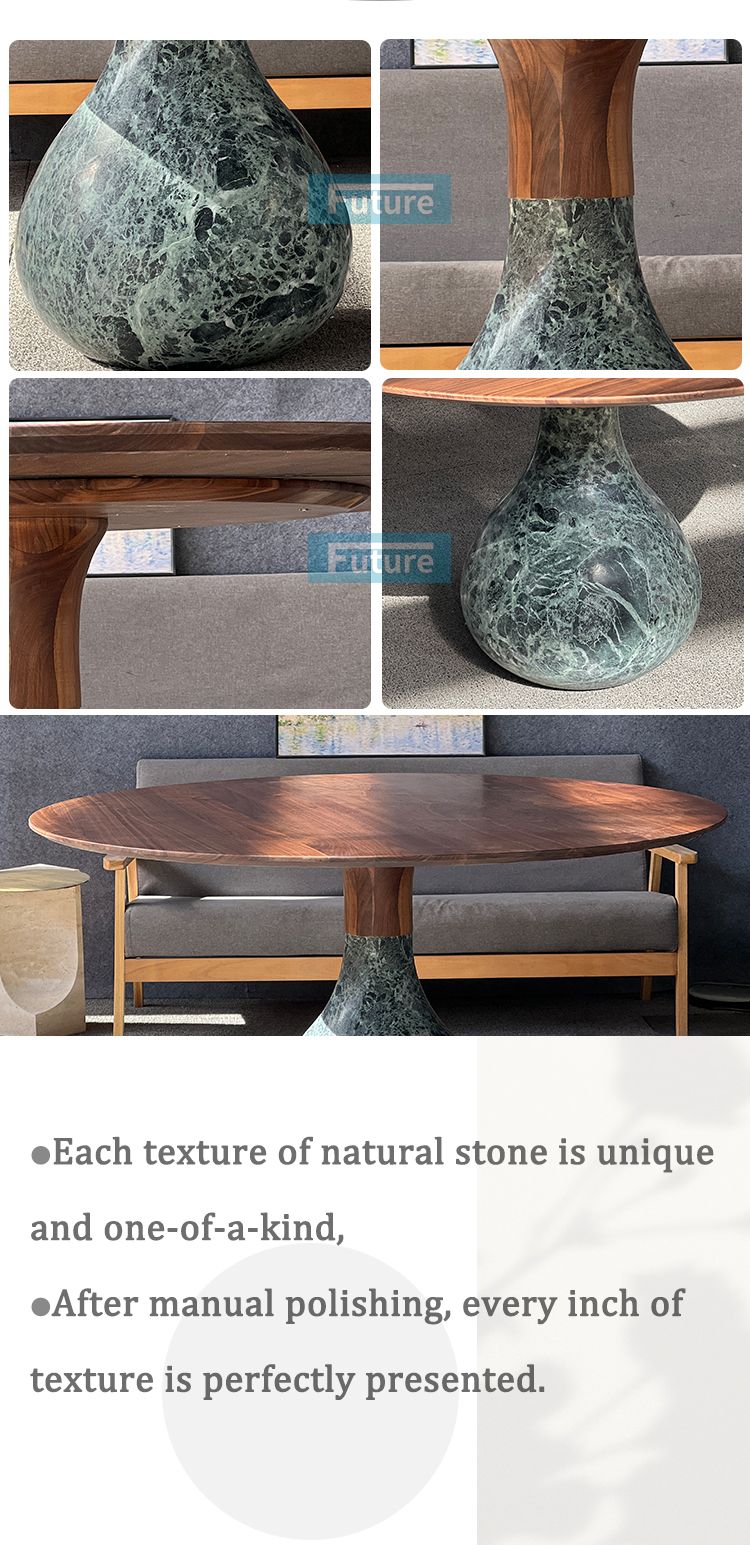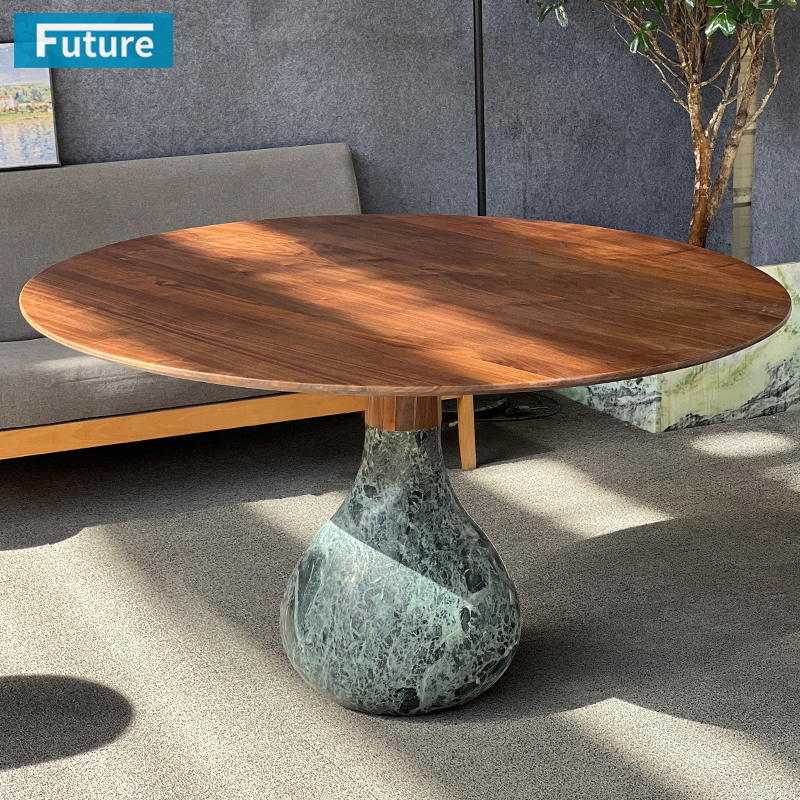A marble dining table has a presence that few other materials can match, turning a basic dining area into a space that feels curated, architectural, and intentionally designed. When properly engineered and maintained, a marble dining table offers long-term durability as well as visual impact, making it a compelling choice for luxury homes, villas, and hospitality projects.
Why marble belongs in the dining room
For centuries, marble has been used in architecture and sculpture for its density, workability, and luminous surface. In contemporary interiors, these same properties translate into dining tables that feel both sculptural and practical, especially when paired with stable bases and modern protective treatments.

Unlike synthetic materials, each marble slab has its own veining and color variation, so every marble dining table is effectively a one-of-a-kind piece. Light marbles such as Carrara and Calacatta create bright, gallery-like dining rooms, while dramatic stones like Calacatta Viola, Black Marquina, or deep green marbles add rich, expressive character.
Understanding stone types and finishes
From a technical standpoint, the choice of stone and surface finish has a direct impact on both performance and aesthetics. Classic white marbles such as Carrara White and various Calacatta stones are relatively dense but still more porous than engineered quartz, so they benefit from proper sealing and sensible daily care in dining applications.
Colored marbles—India green, Rosa Levanto, red-toned stones, and other exotics—offer stronger patterning and are often selected for feature dining tables in villas and boutique hotels. Travertine and travertine-look stones provide a softer, more tactile look but tend to have more open pores, so filled and honed finishes are usually preferred in high-traffic dining environments.

Finish selection is equally important. Polished marble amplifies light and veining but makes etching more visible, while honed or leathered finishes are slightly more forgiving to everyday marks and micro-scratches. In hotels and busy restaurants, designers frequently specify honed marble dining tables to balance a luxurious appearance with realistic maintenance demands.
Proportions, dimensions, and engineering
A marble dining table is only as successful as its engineering, especially with large spans and heavy tops. For stone surfaces, typical table-top thicknesses range from around two to five centimeters, with the thicker end of the range often chosen for larger, freestanding marble dining tables to ensure rigidity and visual weight.
Rectangular marble dining tables of around 220 centimeters by 110 centimeters and approximately 75 centimeters high are widely used in villas and hotel dining rooms, seating eight to ten people while still allowing comfortable circulation around the table. When specifying such pieces, engineers and fabricators need to consider the weight of the slab, the footprint and stability of the base, the load-bearing capacity of the structure, and the floor build-up, because a solid stone top of this size can easily weigh more than 150 kilograms and may approach or exceed 200 kilograms depending on thickness and stone type.
Round tables follow similar principles. One documented example is a round marble dining table with a diameter of about 120 centimeters and a weight of roughly 240 kilograms, which illustrates how quickly mass increases with wider tops. For both round and rectangular formats, designers and fabricators must coordinate early on structural reinforcement, delivery access, and installation methodology.
Base design and structural support
Because marble is heavy and relatively brittle under concentrated loads, base design is as much an engineering problem as an aesthetic one. High-quality marble dining tables typically use bases in steel, solid wood, or engineered metal structures that spread the load evenly and provide continuous support, particularly near edges and joints.

Pedestal bases are a popular choice for round and oval marble dining tables because they free up legroom and encourage more social seating arrangements. However, the pedestal needs enough width, weight, and internal reinforcement to prevent tipping and to carry the concentrated load in the center where the slab meets the base. For long rectangular tables, designers often rely on a concealed metal frame combined with sculptural legs, achieving a slim visual profile without compromising stability.
Aesthetic directions: from minimalist to grand
Design language for marble dining tables now ranges from ultra-minimal to deeply expressive. On the minimal side, slim white marble tops on simple metal frames can almost disappear in the space, acting as a calm, refined surface that supports rather than competes with the rest of the interior.
At the expressive end, thick Calacatta Viola slabs on monolithic stone or metal pedestals, or black marbles with strong white veining, become the main sculptural element in an open-plan living–dining area. Softly rounded rectangles, oval “boat” shapes, and tops with eased corners are increasingly popular, making large tables feel more inviting and visually lighter in contemporary spaces.
Future Stone Group reflects this spectrum in its own portfolio, offering wabi-sabi inspired beige and travertine-look round tables, modern green and red marble rectangles, and classic Carrara or Calacatta pieces tailored to European, American, and Middle Eastern tastes. This variety allows designers to align the marble dining table precisely with brand language, from understated resort villas to dramatic urban penthouses.
How a marble dining table shapes the room
The dining table often sits at the physical and emotional center of a home or hospitality venue, so the choice of marble has a strong influence on the atmosphere of the entire space. Marble’s reflective qualities help bounce both natural and artificial light, which can make dining rooms feel brighter and more open, especially when combined with light-colored walls and warm-toned lighting.
Because marble is harder and more reflective than timber, it also affects acoustics by reflecting more sound into the room. To balance this, designers typically pair marble dining tables with upholstered chairs, rugs, curtains, and wall panels that absorb sound and create a comfortable noise level, particularly in larger dining rooms and hotel restaurants. In open-plan layouts, a marble dining table can also act as a material bridge between a stone kitchen island, floor finishes, and architectural details, tying the entire space together.
Real-world case: boutique hotel dining
In a high-end city hotel, the aim is often to create a sense of quiet luxury that guests immediately feel when they enter public and private dining areas. One documented project uses a restrained palette of wood, glass, and stone, with marble surfaces placed strategically in dining and lounge spaces to signal permanence and quality.

Custom marble dining tables in these suites and private dining rooms are specified with honed finishes, neutral tones, and controlled veining, supporting the hotel’s brand story of timeless elegance rather than short-lived trends. Carefully defined dimensions, edge details, and base designs ensure that the tables work ergonomically for room service and event catering while still reading as sculptural centerpieces.
Real-world case: luxury villa dining room
In a luxury villa or high-end residence, the dining table is expected to handle everyday family use and special occasions with equal ease. A typical solution for such projects is a rectangular marble dining table around 220 centimeters long, using stones such as Carrara, Verde Green, or Rosa Levanto combined with a metal base that echoes the home’s door hardware, lighting, or stair balustrades.

Future Stone Group showcases similar residential applications, including red marble and green marble dining tables sized for eight to ten people, with softened corners and edges for comfort and safety. In these homes, the dining table often aligns with marble flooring, stair treads, and console tables, creating a coherent material language across the ground floor.
Styling strategies for everyday life
Styling a marble dining table is about revealing the stone rather than concealing it under heavy layers of decor. Many interior stylists recommend keeping the center of the table relatively clear and focusing on a single strong element—a sculptural vase, a bowl with seasonal fruit, or a compact floral arrangement—that can be easily moved when the table is in full use.
Lighting is one of the most powerful styling tools. A pendant or chandelier centered above the marble dining table defines a vertical axis in the room and draws the eye to the stone surface, while dimmable warm-white bulbs reduce glare on polished finishes and create a softer evening atmosphere. Chairs then fine-tune the mood: slim metal frames or molded shells work well in modern apartments, while fully upholstered chairs with higher backs suit formal dining rooms and hotel private dining spaces.
For compact spaces with small round marble tables, open or curved-back chairs help maintain visual lightness and keep circulation comfortable. In larger rooms, a mix of armchairs at the heads of the table and simpler side chairs along the length can add a subtle hierarchy without competing with the marble itself.
Practical maintenance and long-term care
Marble is a natural material that rewards a bit of attention, and clients appreciate clear, realistic guidance on how to look after their dining tables. Daily cleaning is simple: use a soft cloth with a mild, pH-neutral cleaner or diluted dish soap, then dry the surface to avoid water spots.
Because marble can etch and stain when exposed to acids and strong pigments, liquids such as wine, coffee, citrus juice, and oil should be wiped up promptly. Coasters, placemats, and heat-resistant trivets are small accessories that significantly reduce the risk of marks from hot pans, rough ceramic bases, or strongly colored beverages.
Most stone-care professionals recommend periodic sealing of marble tops, with timing depending on the specific stone, finish, and intensity of use. For chips, deeper scratches, or widespread etching, professional refinishing is the best route, ensuring that sheen and texture are restored consistently across the entire surface.
How marble compares with other dining table materials
When clients compare marble with timber, glass, or engineered stone, it helps to define the trade-offs clearly. Marble offers unique natural patterning and a sense of permanence but is heavier and more porous than many engineered surfaces, and it is more sensitive to acids and some cleaners.
Compared with hardwood, marble does not develop the same kind of patina from dents and scratches, yet it will show etching and staining if neglected, which some owners accept as part of the stone’s evolving character. In hospitality settings, some operators choose marble dining tables for statement areas—such as lobbies, signature restaurants, or private dining rooms—while using more forgiving materials for breakfast zones and high-turnover spaces.
Specifying marble dining tables for projects
For architects, interior designers, and procurement teams, a precise specification is essential to ensure that the delivered marble dining table matches the design intent. A robust specification typically covers stone type, finish, thickness, table dimensions, edge details, base material and finish, fixing methods, and any structural requirements for the floor or subframe.
Manufacturers such as Future Stone Group support this process with detailed shop drawings, three-dimensional models, and slab selection photos so that clients can approve the exact veining and color before production. Their catalog includes marble dining tables in Carrara, Calacatta Viola, Black Marquina, green and red marbles, as well as travertine and quartz options, which allows the same design language to be adapted across different budgets and market segments.
Working with Future Stone Group as a manufacturing partner
Future Stone Group operates as a global stone supplier and specialist furniture manufacturer, producing marble dining tables, coffee tables, and other stone pieces for luxury residences, hotels, and commercial projects. The company’s dining table range includes round, oval, and rectangular models in premium marbles such as Carara White, Calacatta Viola, Verde Green, Rosa Levanto, and Black Marquina, with base options designed for modern, classic, and wabi-sabi interiors.
With extensive experience in custom stone fabrication, Future Stone Group can provide custom sizing, OEM and ODM cooperation, and coordinated stone packages that combine tables with matching flooring, staircases, wall panels, and vanity tops. For homeowners, designers, and developers who want a marble dining table that truly acts as a statement piece, this integrated approach ensures that design, engineering, and logistics are handled by a single specialist partner from slab selection all the way through to final installation.



